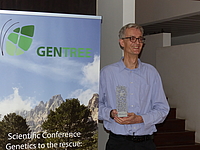By Oliver Reutimann
Conducting and interpreting genetic association studies can be complex and challenging. This summer school aimed to offer us a better understanding of the methods used and the theory behind association studies, in order to broaden the picture of forest genetics.
From genotypes to phenotypes – Twenty-one people from around the world, with different backgrounds, came together in Kaunas, Lithuania, to learn more about theories and methods underlying this rather specific field of biology. Four days filled with several lectures and one excursion covered a broad range of topics. Participants gained insights into general population genetics, coalescent theory, genotype-phenotype association, phenotypic predictions and high throughput phenotyping.
On the last day of the course, we had the chance to visit some impressive provenance trial sites outside of the university campus. This excursion was combined with a demonstration of how drones can be applied for high throughput phenotyping in the forest.
The organisers of the course also took the opportunity to present us the rich history of Lithuania by showing us some beautiful castles in the region, including the famous Trakai Island Castle. The excursion contributed to the very diversified agenda of the course and gave us all the chance to get some fresh air to digest the content of the previous days.
A really funny farewell dinner rounded up the course and after four intensive days, a well organised and inspiring summer school had come to an end.
This blog post was selected as the winner of a contest organised as part of the training course.
The training course was organized in collaboration with EVOLTREE and INRA France.


From drones to castles – The course took place at Aleksandras Stulginskis University near Kaunas, the second biggest city of Lithuania, with a picturesque old town. The city itself is embedded in a beautiful landscape with a lot of forests, which cover about one third of the land area of Lithuania.

Evolutionary forces shape genetic variation and leave genomic imprints. The resulting genetic characteristics can be associated with phenotypic traits or even predict them. Plant breeders and conservation biologists often rely on information from such genetic associations. Therefore, understanding the methods and the statistics behind the methods used for association studies and phenotypic predictions is crucial for people who work in these fields.
PhD students, researchers and other people who attended the course were provided with theoretical knowledge and practical examples to improve their skills in population and quantitative genetics as well as in bioinformatics. Five experienced teachers guaranteed for constructive and passionate discussions during the lectures (and also during the breaks or over a beer in the evening).


